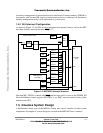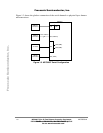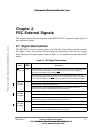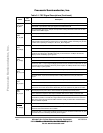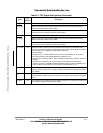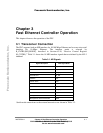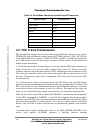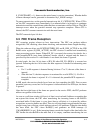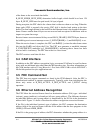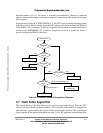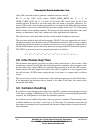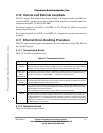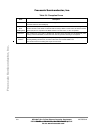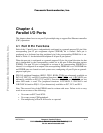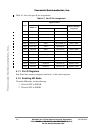
MOTOROLA Chapter 3. Fast Ethernet Controller Operation 3-3
PRELIMINARYÑSUBJECT TO CHANGE WITHOUT NOTICE
(I_EVENT[BABT] = 1); however, the entire frame is sent (no truncation). Whether buffer
or frame interrupts can be generated is determined by I_MASK settings.
To pause transmission, set the graceful transmit stop bit, X_CNTRL[GTS]. When GTS is
set, the FEC transmitter stops immediately if no transmission is in progress or continues
transmission until the current frame either Þnishes or terminates with a collision. The GRA
interrupt occurs when the graceful transmit stop operation completes. When GTS is
cleared, the FEC resumes transmission with the next frame.
The FEC transmits bytes lsb Þrst.
3.3 FEC Frame Reception
FEC reception requires almost no host intervention. The FEC can perform address
recognition, CRC checking, short-frame checking, and maximum frame-length checking.
When the software driver sets ECNTRL[ETHER_EN] and R_DES_ACTIVE in the CSR
RxBD active register (R_DES_ACTIVE), the FEC receiver is enabled and immediately
starts processing receive frames. When RX_DV is asserted, the receiver Þrst checks for a
valid preamble/SFD (start frame delimiter) header, which is stripped and the frame is
processed by the receiver. If a valid header is not found, the frame is ignored.
In serial mode, the Þrst 16 bit times of RX_D0 after RX_DV (RENA) is asserted are
ignored. Following the Þrst 16 bit times the data sequence is checked for alternating ones
and zeros.
¥ If a 11 or 00 sequence is detected during bit times 17 to 21, the rest of the frame is
ignored.
¥ After bit time 21, the data sequence is monitored for a valid SFD (11). If a 00 is
detected, the frame is rejected. If a 11 is detected, the preamble/SFD sequence is
complete.
In MII mode, the receiver checks for at least one byte matching the SFD. Zero or more
preamble bytes may occur, but if a 00 sequence is detected before the SFD byte, the frame
is ignored.
After the Þrst eight bytes of the frame are passed to the receive FIFO, the FEC performs
address recognition on the frame.
As soon as a collision window (64 bytes) of data is received and if address recognition has
not rejected the frame, the FEC starts transferring the incoming frame to the RxBDÕs
associated buffer. If the frame is a too short (due to collision) or is rejected by address
recognition, no receive buffers are Þlled. Thus, no collision frames are presented to the user,
except for any late collisions, which indicate serious LAN problems. When the data buffer
has been Þlled, the FEC clears RxBD[E] and generates an RXB interrupt (if
I_MASK[RBIEN] is set). If the incoming frame exceeds the length of the data buffer, the
FEC fetches the next RxBD in the table and, if it is empty, continues transferring the rest
Fr
eescale S
emiconduct
or
, I
Freescale Semiconductor, Inc.
For More Information On This Product,
Go to: www.freescale.com
nc...



